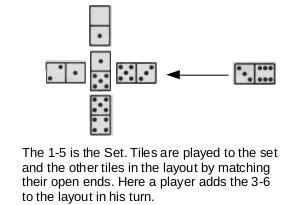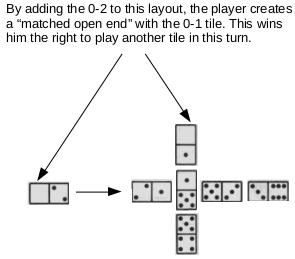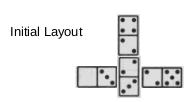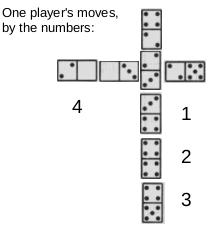Curse of the Doublet (aka Flaken's Frustration)
Invented by Howard Fosdick © BestFreeNewGames.com
Overview: This game is very easy to learn, yet it can be difficult to prevail against a skilled opponent. It's easy to play and tough to win.
Players and Equipment: 2 players use a standard set of 6-6 dominoes.
Objective: To win the hand (or deal) by being the first player to domino (go out). To win the Game by being the first player to accumulate 11 points across hands.
Start: All tiles are placed face down and shuffled. Each player takes 11 tiles. The remaining 6 dominoes are placed aside face down and are not used in the game.
The Set: For the first hand, flip a coin to determine who goes first. In subsequent hands, the loser of the prior hand dictates who goes first.
The first player leads any tile from his hand face up as the foundation tile or the set. The set is laid vertically between the two players in the playing area. The player who plays the set only plays that one domino in his turn. Then his opponent takes his first turn.
Play: Each in his turn, a player plays one or more tiles from his hand to the developing layout. If he cannot play any piece, he says "pass". A player is required to play a domino if he has a valid one to play.
Play a tile to the layout by matching one of its ends to one of the four open ends of the layout. Play develops four directions off the set, like this:

The set has two open or playable sides for each of the two numbers on its face. In this example, the 1-5 set has two open positions for tiles with 1's and two open positions for tiles having 5's (as shown above).
A doublet set requires all four tiles played against it to have the same connecting number. For example, setting the 4-4 requires all four tiles played against the set to have a four-pip on the side adjoining the set.
Play proceeds in four directions off the set. There are no requirements or restrictions on playing tiles to the layout other than that the tile connect to and match an open end of some tile already in the layout. (For example, play might proceed rapidly in one direction off the set, while play doesn't even start in some other direction.)
Extra Plays: If a player plays a domino that creates a new matched open end with any of the other three branches of the layout, he gets to play another tile in that turn. Here's an example:

A player continues playing dominoes in his turn as long as he plays tiles that create new matched open ends in the formation. Then he ends his turn by playing one domino beyond his last matching play. (Thus, each domino played in the series except the last one must create a new matched open end.)
If a player plays a domino that creates a matched open end, but then does not have any further valid domino to play, he says "pass" and his turn ends.
If a player cannot create a matched open end by his play, he plays exactly one tile in that turn.
A player cannot create a matched open end involving the set. That is, only matches against open ends other than those of the set itself count for extra plays.
Example Play: Here's an example turn to illustrate. The set was the 2-3, and say this is the current layout:

The open ends of this formation are 0, 4, 5, and 3 (off the set). In his turn, a player must play a connecting tile to one of these open ends if he can. Otherwise, he says "pass". He can keep playing tiles as long as he creates new open end matches.
Let's assume a player has the 3-4, 4-4, 4-5, and 0-2 dominoes in his hand. Here's what he plays in his turn:

First, the player lays down the 3-4 tile. This creates an open end match (between the 4 on the 3-4 just played, and the 4 on the 4-2 tile. So the player wins the right to play another tile.
Next, he places the 4-4 domino to the layout. Again, the player has created an open end match, this time between the 4 on his doublet 4-4 and the open 4 on the 4-2 tile. So he gets another play.
For his third tile of the turn, the player lays down the 4-5. This creates an open end match with the 2-5 tile based on the matching 5's. The player again wins the right to play another domino. (Note he might alternatively have played the 4-5 off the 2-5 tile, which would create an open end match between the 4-5 and both the 4-4 and 4-2 bones. There is no advantage to creating more than one new open end match in a single tile placement. The player lays the 4-5 domino where he believes it might do him the most good in future turns, and his opponent, the most harm.)
As his last move, the player adds the 2-0 tile to the layout. Its open end, a 2, creates no new open end match with any other branch of the layout, so this ends the player's turn.
Hand End: The hand ends either when either player goes domino (empties his hand by playing all 11 of his tiles to the layout), or when both players are forced to say "pass" back-to-back.
Scoring: If a player goes out or dominoes, he wins the hand and scores 1 point for each domino left in his opponent's hand. If a player creates a new matched open end with the domino on which he goes out, he scores 1 extra point.
If neither player goes out (the game ends blocked because the two players said "pass" back-to-back), then neither scores any points in the hand. The hand ends tied with the final score: 0 - 0.
Game: Game is won by the first player to attain 11 points across hands.
-----------------------------------
Tips for Play: The goal is to create as many new matching open ends in series as possible in order to play more dominoes in one's turn and go out more quickly. Think carefully about how to create such a series before playing a tile.
Doublet tiles can be difficult to play, especially later in the game, since they require a single specific open end on the layout. Hence the name, "Curse of the Doublet". Unless one has an appropriate connecting tile in hand, it's often best to play doublets early in the game before your opponent conjectures which you might hold. He might well try to block you from playing any doublets he suspects you hold.
Defence is as important as offence. For example, playing a tile off the domino your opponent just played may prevent him from "setting up" for an open-end match in his next turn. Good players block the game late in play if they are behind or in difficulty. This secures a draw rather than a loss.
-----------------------------------
License: Feel free to print, copy, and distribute these rules, so long as you retain this paragraph. Invented by Howard Fosdick © 2023, distributed under Creative Commons License CC BY-NC-ND. HOME